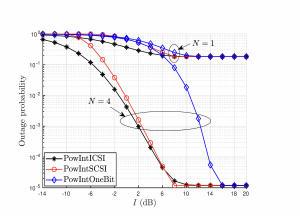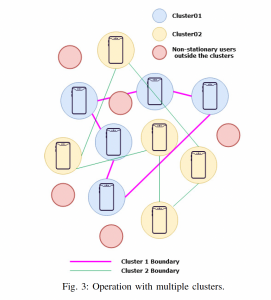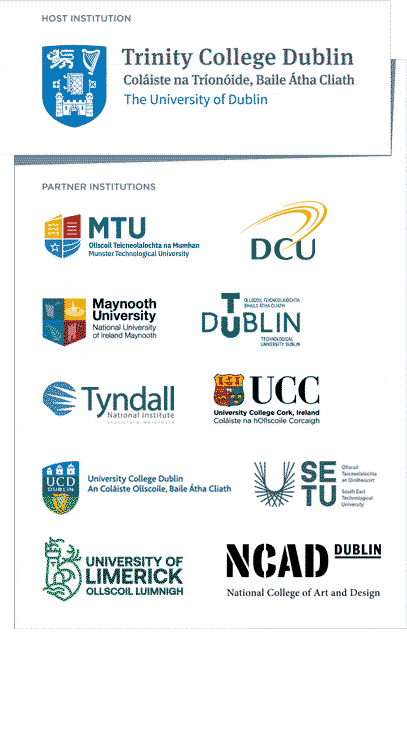Here are some recent high-impact publications from CONNECT researchers…
A Stochastic Model for UAV Networks Positioned Above Demand Hotspots in Urban Environments
Authors: Boris Galkin, Erika Fonseca, Ramy Amer, Luiz A. DaSilva and Ivana Dusparic
Journal: IEEE Transactions on Vehicular Technology
What’s this paper about?
Drones will soon use the mobile phone network to communicate with their pilot, air traffic control entities, and each other. Typical mobile phone networks are designed to cover mobile phones at street level; drones will find it difficult to connect to these networks when flying in the air. Drones can avoid this by using artificial intelligence (AI) to take in information about their surrounding environment and intelligently choosing which mobile phone towers to connect to during flight, to maximise their received service quality.
What have you discovered?
In our paper we propose an algorithm called REQIBA, which makes use of two types of machine learning -Supervised Learning and Reinforcement Learning- to allow a drone to intelligently connect to the mobile phone network. The supervised learning component of the algorithm is used to predict the radio channel quality for several nearby mobile phone towers, based on their known locations relative to the drone and information about buildings in the area. The reinforcement learning component is used to decide which of those base stations the drone should be connected to at any given moment during flight.
So what?
Using in-depth simulations, we demonstrate that our REQIBA algorithm can learn to successfully connect drones into the best mobile phone towers during flight. This can as much as double the total data throughput of the network connection, compared to the performance if the drone was to connect into the network the way mobile phones typically connect into the network. This clearly demonstrates that drones can indeed adapt to existing mobile phone networks for their data connection to the pilot, but that they require special AI tools to achieve this.
Read the full paper here (pdf).
Cyber Security Framework for Vehicular Network Based on a Hierarchical Game
Authors: Hichem Sedjelmaci, Imane Horiya Brahmi, Nirwan Ansari and Mubashir Husain Rehmani
Journal: IEEE Transactions on Emerging Topics in Computing
What’s this paper about?
Future smart cities will be equipped with electric and autonomous vehicles. These vehicles will be composing vehicular ad hoc network (VANET) to make road safer and the travelling experience more pleasant by collaborating and sharing information among each other. These vehicular ad hoc networks will be using advanced communication technologies to communicate with its neighbouring cars and the external network, e.g. Internet. However, they will be subject to range of cyber threats. Thus, a reliable and efficient cyber security framework is mandatory to protect vehicular networks against the cyber attackers.
What have you discovered?
In this research work, we have proposed an efficient cyber security framework, where a trade-off between the network and security metrics is achieved by using a hierarchical cooperative game using Game Theory. Furthermore, we have gained a new insight from a security cooperative game, where the head agent collaborates with the secondary agents to predict and detect with a high accuracy the lethal attacks, while taking into consideration of the overhead and delay.
So what?
This will protect future vehicular ad hoc networks and make the travelling experience more secure and safer.
Read the full paper here (pdf).
On the performance of downlink NOMA in underlay spectrum sharing
Authors: Vaibhav Kumar, Zhiguo Ding and Mark F. Flanagan
Journal: IEEE Transactions on Vehicular Technology 2.243
What’s this paper all about?
The extraordinary growth of internet traffic associated with a plethora of data-intensive applications puts an enormous bandwidth demand on the available spectrum in both licensed as well as unlicensed frequency bands. Therefore, one of the major challenges for the successful deployment of the beyond-fifth-generation (B5G) communication services is to accommodate a large number of wireless/mobile devices over a super-congested wireless spectrum. Non-orthogonal multiple access (NOMA) is one of the recently proposed solutions to mitigate the problem of spectrum scarcity, as it has the potential to provide massive connectivity along with a higher achievable data rate. In this paper, we have (through rigorous performance analysis) showcased the advantages of using NOMA in a spectrum sharing system.
What exactly have you discovered?
In general, spectrum sharing between a licensed (primary) network and an unlicensed (secondary) network can increase the spectral efficiency of the overall wireless communications network. In the approach known as underlay spectrum sharing, the secondary-user transmitter transmits simultaneously with the primary-user transmitter using the band of frequencies originally owned by the primary network, in such a manner that the interference inflicted by the secondary network on the primary network is below a tolerance limit. In this paper, we have rigorously analyzed the performance of such a system. We show that the spectrum sharing NOMA system outperforms the corresponding orthogonal multiple access (OMA) approach, and we quantify this improvement. We have also determined a simple and practical formula for the optimal power allocation to be used in the system, and we have captured the effect of imperfect channel knowledge on the overall system performance.
So what?
The analytical framework provided in our paper can be used to design and/or to analyze the performance of a wireless communication system that supports underlay spectrum sharing and non-orthogonal multiple access, forming a foundation for the very spectrally efficient wireless communication schemes of B5G networks.
Read the full paper here (pdf).
Energy Efficient Contact Tracing and Social Interaction based Patient Prediction System for COVID-19 Pandemic
Authors: Charuka Moremada, Chamara Sandeepa, Nadeeka Dissanayaka, Tharindu Gamage, Madhusanka Liyanage
Journal: IEEE Journal of Communications and Networks 3.24
What is this about?
This paper presents a COVID-19 infection prediction system for a Bluetooth Low Energy (BLE) based contact tracing application. We develop a graph-based simulation for social interactions to predict infection spread and compare it with early-stage patient data from multiple countries spread over the world. Furthermore, we implemented a system prototype with a mobile app and interactive web monitoring tool. This work proposes an energy-saving algorithm with a cluster-based approach to reduce the energy consumption of the mobile app.
What have you discovered?
We identified a threshold number of interactions needed for a Polymerase Chain Reaction (PCR) test to minimise the spread of COVID 19. We were also able to reduce battery consumption using our energy-saving algorithm that focused on clusters rather than individuals.
So what?
The prediction of disease spread would help prevent a future outbreak of infection and by making contact tracing apps more efficient, it would encourage more people to download and keep the apps on their phones.
Read the full paper here (pdf).
CONNECT is the world leading Science Foundation Ireland Research Centre for Future Networks and Communications. CONNECT is funded under the Science Foundation Ireland Research Centres Programme and is co-funded under the European Regional Development Fund. We engage with over 35 companies including large multinationals, SMEs and start-ups. CONNECT brings together world-class expertise from ten Irish academic institutes to create a one-stop-shop for telecommunications research, development and innovation.






